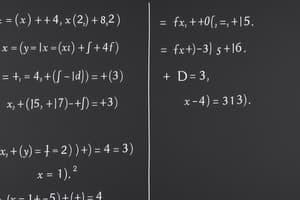Podcast
Questions and Answers
What is the domain of the function $f(x) = \frac{1}{x^2}$?
What is the domain of the function $f(x) = \frac{1}{x^2}$?
- All real numbers except 0
- All real numbers (correct)
- All real numbers except 1
- All real numbers except -1
For the function $f(x) = |x|$, what is the range of the function?
For the function $f(x) = |x|$, what is the range of the function?
- All real numbers
- All non-positive real numbers
- All positive real numbers
- All non-negative real numbers (correct)
If $g(t) = \sqrt{t-2}$, what is the domain of the function?
If $g(t) = \sqrt{t-2}$, what is the domain of the function?
- All non-positive real numbers
- All real numbers
- All real numbers except 2 (correct)
- All non-negative real numbers
For the function $h(x) = \frac{1}{x+3}$, what is the domain of the function?
For the function $h(x) = \frac{1}{x+3}$, what is the domain of the function?
What is the range of the function $p(x) = 3x^2 + 2$?
What is the range of the function $p(x) = 3x^2 + 2$?
For the function $q(x) = \frac{x^2-4}{x-2}$, what is the domain of the function?
For the function $q(x) = \frac{x^2-4}{x-2}$, what is the domain of the function?
What is the domain of the function $r(x) = \frac{1}{\sqrt{x-3}}$?
What is the domain of the function $r(x) = \frac{1}{\sqrt{x-3}}$?
If $g(x) = \sqrt{x-5}$, what is the range of the function?
If $g(x) = \sqrt{x-5}$, what is the range of the function?
If $h(t) = |t-4|$, what is the range of the function?
If $h(t) = |t-4|$, what is the range of the function?
What is the domain of the function $f(x) = \frac{1}{x-7}$?
What is the domain of the function $f(x) = \frac{1}{x-7}$?
Flashcards are hidden until you start studying
Study Notes
Functions
A function is a mathematical object that takes one or more arguments and returns a value based on the provided input. In mathematics, functions are used to describe relationships between sets of objects. They help to model real-world situations, such as the relationship between distance and time when driving a car or the relationship between the volume of a container and the amount of liquid it holds.
Domain
The domain of a function refers to the set of all possible inputs that can be used to evaluate the function. In other words, it is the set of values that can be plugged into the function to get a valid output. For example, consider the function:
$$f(x) = \frac{1}{x}$$
In this case, the domain would be all real numbers except 0, because dividing by 0 is undefined.
Range
The range of a function, on the other hand, refers to the set of all possible outputs that can be obtained by evaluating the function with different inputs. For the given function:
$$f(x) = \frac{1}{x}$$
The range would be all real numbers except 0, because the output will always be a positive real number.
Examples
Consider the following examples to better understand the concepts of domain and range:
-
Given the function: $$f(x) = x^2$$, the domain would be all real numbers, because the square of any real number is always a real number. The range would also be all real numbers, because the square of any real number can be either positive or negative.
-
Given the function: $$f(x) = \frac{1}{x}$$, the domain would be all real numbers except 0, because dividing by 0 is undefined. The range would be all real numbers except 0, because the output will always be a positive real number.
-
Given the function: $$f(x) = \sqrt{x}$$, the domain would be all non-negative real numbers, because taking the square root of a negative number is undefined. The range would be all non-negative real numbers, because the square root of a non-negative real number is always non-negative.
By understanding the concepts of domain and range, we can better analyze the behavior of functions and predict their outputs for different inputs.
Studying That Suits You
Use AI to generate personalized quizzes and flashcards to suit your learning preferences.




